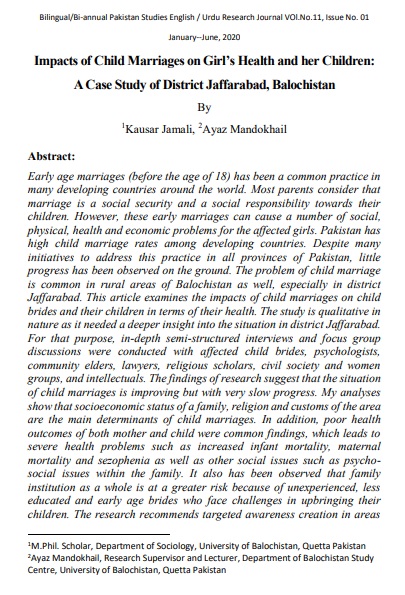Impacts of Child Marriages on Girl’s Health and her Children: A Case Study of District Jaffarabad, Balochistan
Keywords:
Child marriages, Health Impacts, Jaffarabad, Legal & Social Barriers etc.Abstract
Early age marriages (before the age of 18) has been a common practice in
many developing countries around the world. Most parents consider that
marriage is a social security and a social responsibility towards their
children. However, these early marriages can cause a number of social,
physical, health and economic problems for the affected girls. Pakistan has
high child marriage rates among developing countries. Despite many
initiatives to address this practice in all provinces of Pakistan, little
progress has been observed on the ground. The problem of child marriage
is common in rural areas of Balochistan as well, especially in district
Jaffarabad. This article examines the impacts of child marriages on child
brides and their children in terms of their health. The study is qualitative in
nature as it needed a deeper insight into the situation in district Jaffarabad.
For that purpose, in-depth semi-structured interviews and focus group
discussions were conducted with affected child brides, psychologists,
community elders, lawyers, religious scholars, civil society and women
groups, and intellectuals. The findings of research suggest that the situation
of child marriages is improving but with very slow progress. My analyses
show that socioeconomic status of a family, religion and customs of the area
are the main determinants of child marriages. In addition, poor health
outcomes of both mother and child were common findings, which leads to
severe health problems such as increased infant mortality, maternal
mortality and sezophenia as well as other social issues such as psychosocial issues within the family. It also has been observed that family
institution as a whole is at a greater risk because of unexperienced, less
educated and early age brides who face challenges in upbringing their
children. The research recommends targeted awareness creation in areas where this practice is common, especially on health issues, legislative
reforms with strict implementation and monitoring mechanisms ingrained
in legal instruments as well as institutional support through sustained
capacity building of relevant departments, advocacy and other reforms to
prevent the practice of child marriages.
References
A Malhotra, A. W.-R. (2011). Solutions to end child marriage: what the
evidence shows. International Center for Research on Women.
Amin, S. D. (1998). . Transition to adulthood of female garment-factory
workers in Bangladesh. . Studies in Family Planning.
Assembly, P. (2015). THE PUNJAB MARRIAGE RESTRAINT
(AMENDMENT) BILL 2015. Punjab Assembly.
assembly, s. (2014, june 11). rtepakistan.org/wp-content/.../11/The-SindhChild-Marriages-Restraint-Act-2013. Retrieved from
rtePakistan.org.
Bicchieri, J. a. (2014). Norms in the wild: How to diagnose, measure and
change social norms. Oxford University press.
Birchall, Z. (2018, 13 December). girls not brides.org. Retrieved from
/www.girlsnotbrides.org/un-general-assembly-adopts-3rdresolution-on-child-early-and-forced-marriage/.
Birchall, Z. (2018). Un general assembly adopts 3rd resolution on child,
early, and forced marriage. Girls not brides.
Bride, G. N. (2019). Girls Not Bride . Retrieved from Girls Not Bride .
children, S. t. (2013). Save the children. Office of the high commissioner
for humane rights Dagne. (1994). Early marriages in Ntheren
Ethopia. Talor and Francis.
Dagne, H. G. (Nov,1994). Early Marriage in Northern Ethiopia .
Reproductive Health Matters, Vol. 2, No. 4, Motherhood,
Fatherhood and Fertility: For Women Who Do and Women Who
Don't Have Children (Nov., 1994), pp. 35-38 , 35-38.
Gaffney-Rhys, R. (2011). Instrument to combat child marriage. GaffneyRhys, R. (2011). International law as an The International Journal
of Human Rights.
Justice, I. o. (2013). Child marriages in Pakistan. women human rights and
gender section OHCHR.
Khawaja, N. (2015). Jinnah fought to pass law against child marriage in
India. Daily Pakistan Golobal.
Mahavarkar, S. H. (2008). A comparative study of teenage pregnancy. .
Journal of Obstetrics and Gynaecology,.
Pakistan, A. a. (2012). Action aid Pakistan . Retrieved from Action aid
Pakistan: www.actionaid.org/pakistan/Pakistan, I. o. (2012). Child
marriages in Pakistan.
Pakistan, I. s. (2008). Institute for social justice Pakistan.
Raj, A. S. (2010). Association between adolescent marriage and marital
violence among young adult women in India. . International journal
of gynaecology and obstetrics.
Samara, S. S. (December 1996). Early Marriage Among Women In
Developing Countries. International Perspectives on Sexual and
Reproductive Health ·.
Sofia Naveed and Khalid Manzoor Butt. (2015). Causes and Consequences
of Child Marriages in South Asia: Pakistan’s Perspective. South
Asian Studies.
T. Khanna, Verma & E. Weiss. (2011). Child Marriage in South Asia:
Realities, Responses, and the Way Forward. ICWR.
Thornton. (2003). Early Female Marriage in the Developing World. Gender
and development.
Thornton. (2003). Early marriage in the developing world. Gender and
development.
Thornton, J. a. (2003). Early female marrage in developing world. Talor
and Francis.
Thornton, R. J. (July 2003). Early Female Marriage in the Developing
World . Taylor & Francis, Ltd. on behalf of Oxfam , 9-19.
Trust, N. (2015). EARLY AND CHILD MARRIAGE. A LANDSCAPE
ANALYSIS. Girls not brides .
UNFPA. (2010). UNFPA ,REPORT,2010. .
UNICEF. (2014). UNICEF for Every Child . Retrieved from UNICEF.
UNICEF. (2017). UNICEF, for every child. Retrieved from UNICEF.
Upreti, M. (2018). Ending Impunity for Child Marriage in Pakistan. Cneter
of Reproductive Rights , 07-41.
WHO. (2019). WHO. Retrieved from WHO.
WHO. (2019). World Health Orgaisation. Retrieved from World Health
Organisation:
/www.who.int/mediacentre/news/releases/2013/child_marriage_20
/en/women, T. P. (2011). Prevention of Anti-Women
Practices Act. The Punjab comission o the status of women.
Zama, M. (2008). Exchange Marriage System and Family Laws in Pakistan.
South Asia research.
Zaman, M. (2008). Exchange Marriage System and Mulim family Laws in
Pakistan DR. Zama. South Asia Research.
Additional References:
Gangadharan, L. and P. Maitra 2000). The effect of education on the timing
of marriage and first conception in Pakistan: Monash University
(Ref: Nawal M. Nour 2006
Health Consequences of Child Marriage in Africa.



